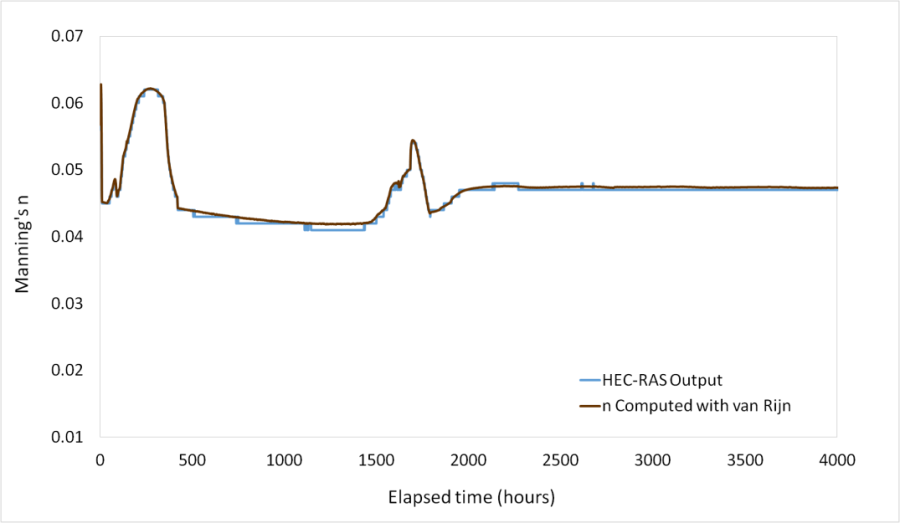- Particle Parameter
|
d_* = d_5_0 \left[ \frac {(s-1)g}{\nu^2} \right]^{1/3} |
Where d50 is the median particle size (ft), s is the specific gravity ratio (s = \frac{\rho_2}{\rho}), where ρs is the sediment density, and ρ is the fluid density, g is the gravitational acceleration and ν is kinematic velocity.
Transport Stage Parameter:
|
T = \frac{(u'_s)^2-(u_{*,cr})^2}{(u_{*,cr})^2} |
Which u*'is grain bed-shear velocity:
|
u'_* = \frac{g^{0.5}}{C'}\=u |
where u is mean flow velocity, C' is the Chezy-coefficient.
|
C' = 18log \left(\frac {12R}{3d_{90}} \right) |
where R is the hydraulic radius of the bed, u*,cr is the critical Shields parameter
|
u_{*,cr} = \sqrt{\frac{\tau_{cr}}{\rho}} |
where τcr is the critical shear stress, and it is expressed as \tau_{cr} = \tau^*_c \rho R g d_5_0, and the dimensionless critical shear is computed with the equation
|
\tau^*_c = 0.5 \left[ 0.22Re_p^{-0.6} + 0.06 \times 10^{(-7.7 Re_p^{-0.6})} \right] |
where
R = \frac {\rho_s - \rho} {\rho}, and Re_p = \frac {\sqrt{gRD}D} {\nu}, and ρ is the fluid density. Bed-form dimensional parameters: The Bed-form parameter computes the bed form dimensions which the algorithm uses in the roughness computation:
|
\frac{\Delta}{h} = 0.11 \left[ \frac{d_{50}}{h} \right]^{} \left[ 1-e^{{-0.5T}} \right] \left[25 - T\right] \vspace{1} \frac{\Delta}{\lambda} = 0.015 \left[ \frac{d_{50}}{h} \right]^{} \left[ 1-e^{{-0.5T}} \right] \left[25 - T\right] |
and it computes a ratio of the bed form height to the wavelength:
|
\psi = \frac{\Delta}{\lambda} |
Where ∆ is bed-form height, λ is bed-form length and is expressed as λ=7.3 h, and _h_ represents flow depth. If T≤0 and T≥25, bed would be considered almost plane, and C' calculated in step 2 will be used as Chezy-coefficient in step 4 for further calculation. ψ is bed-form steepness.
Equivalent roughness of bed forms: Finally, the algorithm uses the bed form height and height-to-wavelength ratio to compute a bed roughness.
|
k_s = 3d_{90} + 1.1\Delta \left[ 1-e^{-25\psi} \right] |
Van Rijn computes a Chezy-coefficient from the bed roughness:
|
C = 18log \left( \frac {12R}{k_s} \right) |
HEC-RAS converts the Chezy coefficient to a Manning's n (in English units) with the equation:
|
n = 1.49 \frac {R^{1/6}} {C} |
An example roughness time series, using van Rijn (in HEC-RAS unsteady sediment transport) for a sand delta rapidly prograding into a gravel cross section, is included in the figure below.
